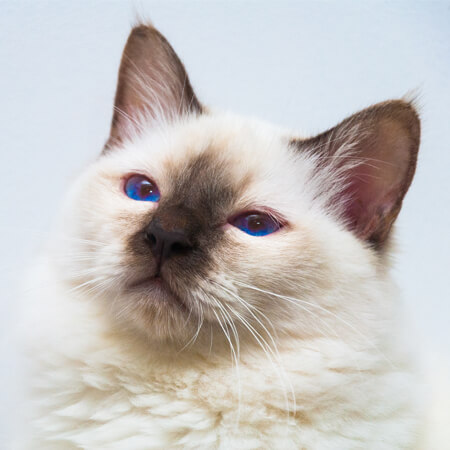The history of the Sacred Cat of Burma
There are many origin stories claiming to provide the definitive history of the Sacred Cat of Burma. How did these Birman cats become “sacred” in the first place? One narrative has these cats living for centuries in complete isolation in a temple in the southeast Asian country known today as Myanmar. It is said that the cats got their white paws and blue eyes after touching a saintly priest in the temple; the holiness of that monk then passed to the Birman cat as they were on their death bed, hence the name “Sacred Cat of Burma”. The fact is that cats from Burma somehow made their way to Europe around 1900. Reports of this cat breed were already made in the 1920s in France and it was first recognised in 1925.
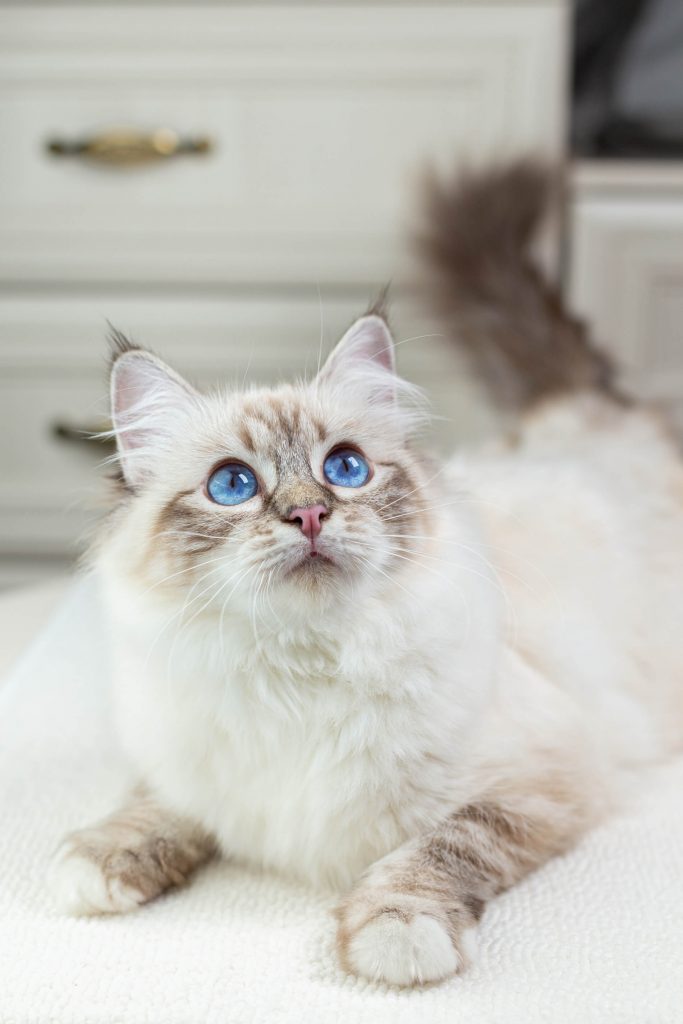
The appearance of the Sacred Cat of Burma
As far as the appearance of the Sacred Cat of Burma is concerned, they look like a cross between a Siamese and a Persian. In fact, the cats that were involved in the initial breeding of the Birman were mainly Siamese cats, colourpoint Persians and local French cats with white paws. To this day, the typical characteristics of Sacred Birmans are their white paws, distinctive markings and blue eyes. If you like fluffy long-haired cats, you’ll definitely get your money’s worth with the Sacred Cat of Burma! The Himalayan colouring is a special feature of these blue-eyed beauties: much like Siamese and Burmese cats, they have distinctive darker markings on their head, legs and tail.
Size of the Sacred Cat of Burma
How big does a Sacred Cat of Burma get when it’s fully grown? These cats have a growth phase that’s only complete after 24 months; at this point, they will have reached their final size. When fully grown, their shoulder height will reach roughly 30 cm as measured from their oval front paws to the highest point of their shoulder blades. This makes the Sacred Cat of Burma a medium-sized cat. They have a medium-weight body that is well-proportioned and slightly elongated. Although they’ve inherited a few genes from the Persian cat, the head of the Sacred Birman is neither round nor pointed and their noses are not shortened.
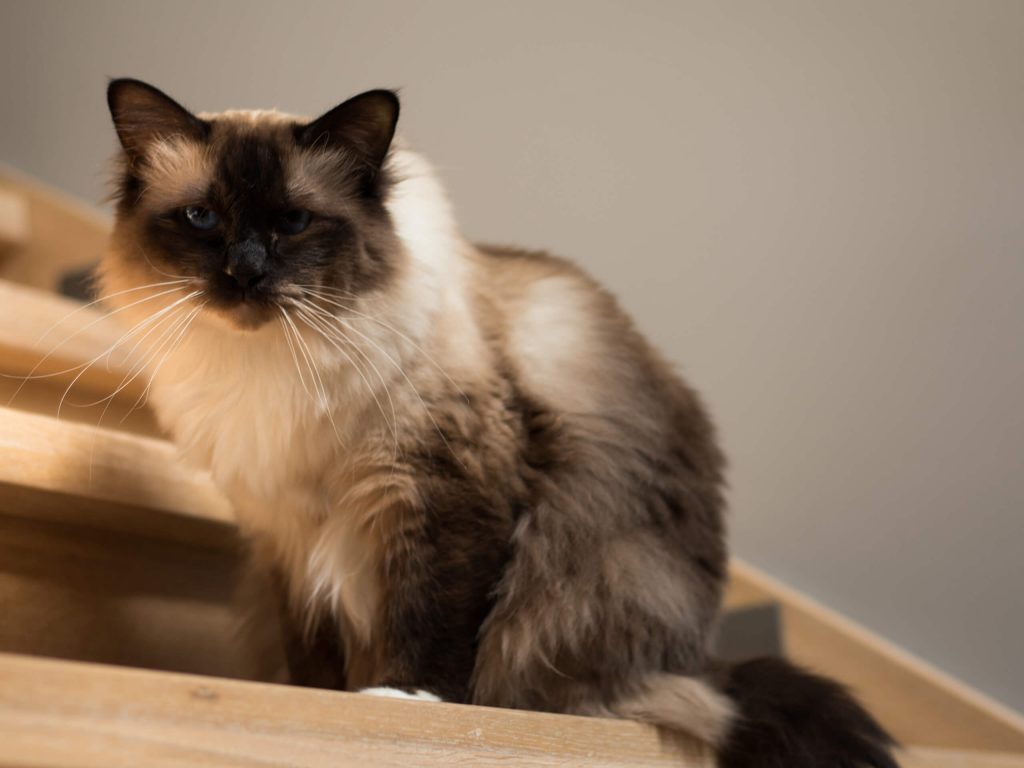
Weight of the Sacred Cat of Burma
How much does the Sacred Cat of Burma weigh? Are there any major differences in the weight of the female and male Sacred Cat of Burma? The males of many species in the animal kingdom tend to want to impress the females with their large and imposing appearance. Do the two sexes of this breed differ greatly in their appearance? Female Birmans come in at around 3.5 to 4 kg, while Birman males are slightly heavier than their female counterparts with an average of 4.5 kg to 6 kg.
Coat of the Sacred Cat of Burma
The wonderfully soft, semi-long coat of the Birman cat surrounds it in a fluffy veil. This fur is very thick and bushy and requires regular care. Have you noticed fluff flying around? Cat owners don’t need a thermometer to know that the seasons are changing, they already have a reliable indicator at home – their cat’s coat change. And it’s quite a hairy situation indeed, as the entire coat needs to be changed. The Birman cat is no exception to this rule. However, these cats have an advantage in that they have relatively little undercoat. During coat change season or in the wintertime when the heating is on, it’s possible for these cats to develop dandruff from time to time.
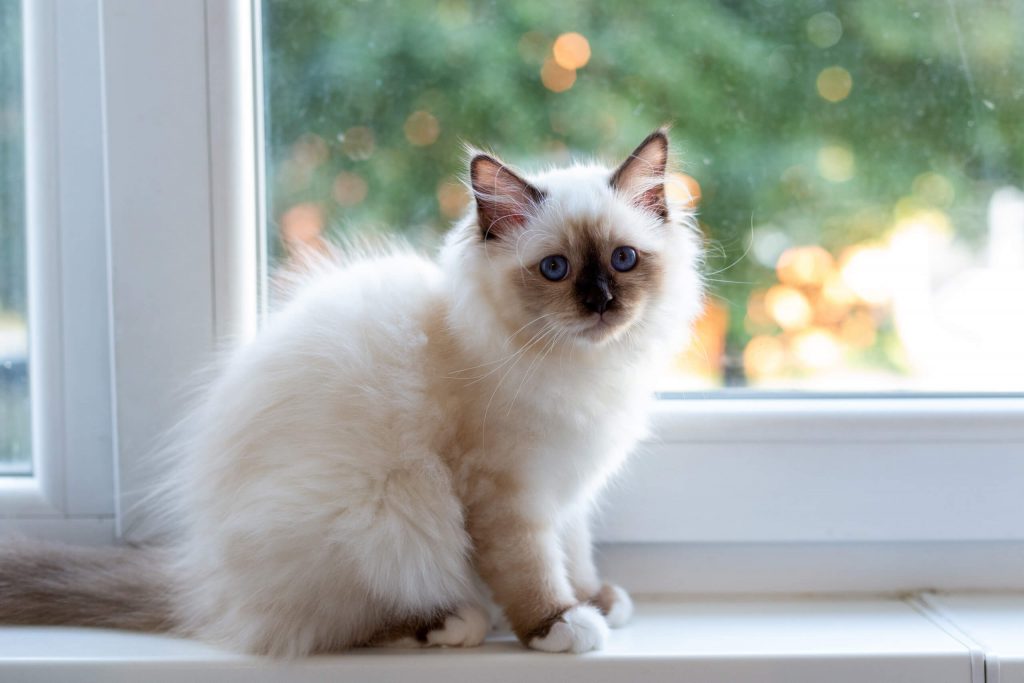
Colour of the coat of the Sacred Cat of Burma
The coat of the Sacred Cat of Burma can have many different colours, the most common being blue, chocolate, lilac and seal. As with all point cats, the base coat colour is always lighter than the colour of the points. A delicate eggshell tone with a golden sheen is particularly prevalent among Birman cats.
NOTE:
A unique feature of the Sacred Cat of Burma is the white “gloves” they have on their front paws. On their hind legs, the white extends a little further up the legs.
Length of the coat of the Sacred Cat of Burma
The Sacred Cat of Burma has a medium-length coat that’s a bit longer on the neck, hind legs and tail. The coat of these cats is very special due to its composition: the Birman cat has relatively little undercoat. Its coat is very dense, but silky soft and wonderfully shiny – like a voluminous, fluffy curtain!
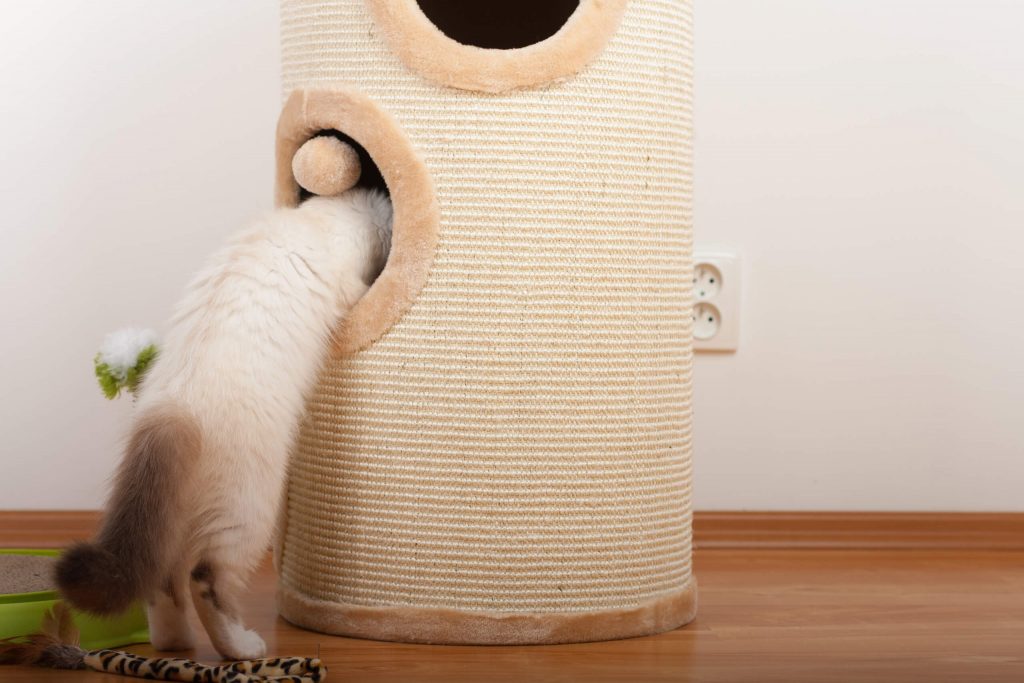
Pattern of the Sacred Cat of Burma
The Sacred Cat of Burma is bred exclusively with a Siamese or colourpoint pattern. In the case of these colour patterns, the markings – referred to as points – are clearly different from the basic tone of the body colour. The Sacred Cat of Burma has mainly blue point, chocolate point, cream point, lilac point, seal point, tabby point and tortie tabby point coat markings. However, Birman cats stand out from other breeds that have colourpoint colouring due to their white “gloves”. In other words, only Birmans have white front paws and hind legs.
Eyes of the Sacred Cat of Burma
Independent of its coat colour and pattern, the Sacred Cat of Burma will always have bright blue eyes. Overall, the eyes of Birman cats are almond-shaped and slightly slanted, albeit not as round as those of Persian cats. These eyes are the source of their “blue magic”: according to the breed standard, the preferred eye colour of the Birman cat is a dark shade of blue, and when you look into these eyes, it really is like looking into a deep lake. The Birman’s gaze is so clear and refreshing that you’ll want to dive all the way to the bottom of those rich blue eyes on your way to infinity…
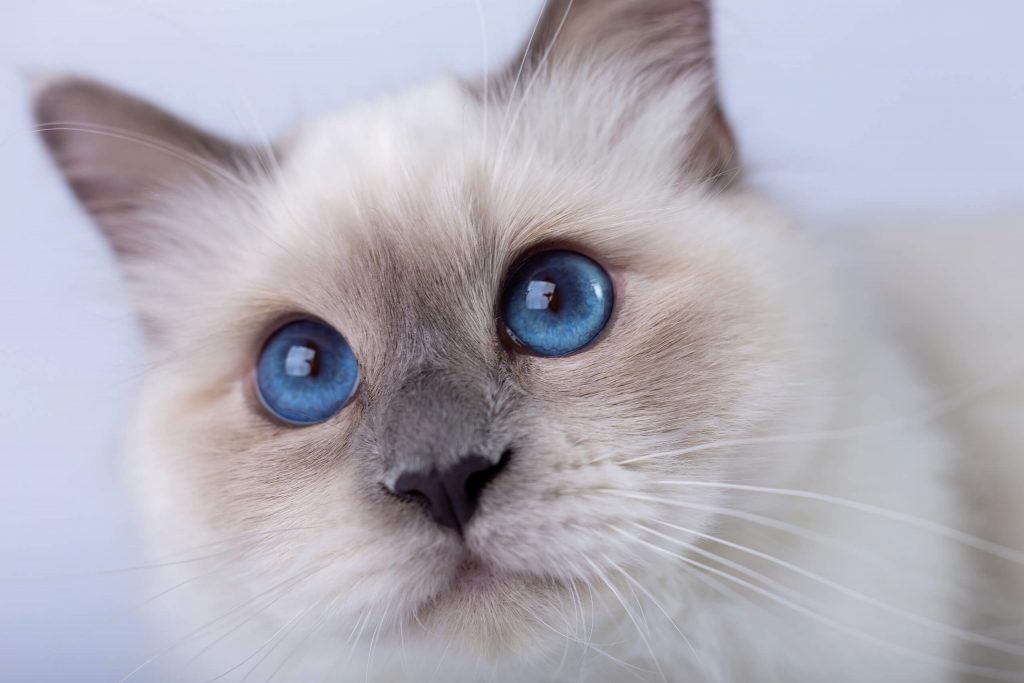
Special features of the Sacred Cat of Burma
One of the special features of the Sacred Cat of Burma is its markings, the so-called “points”. Points is the name given to the darker coloured limbs and muzzle of cats with Himalayan colouring and other colourpoint cats. Still, the Sacred Cat of Burma does not have its points at birth: Birman kittens are completely white when they first see the light of day. The points only develop over time, sometimes taking until the kittens are 12 months old. Their white paws, which are called “gloves”, are a typical feature of the Sacred Cat of Burma. And it’s true; the white leg covering makes it look like the Birman is wearing white gloves or socks. The snow-white gloves and socks on the paws form a wonderful contrast to the darker fur on their strong legs!
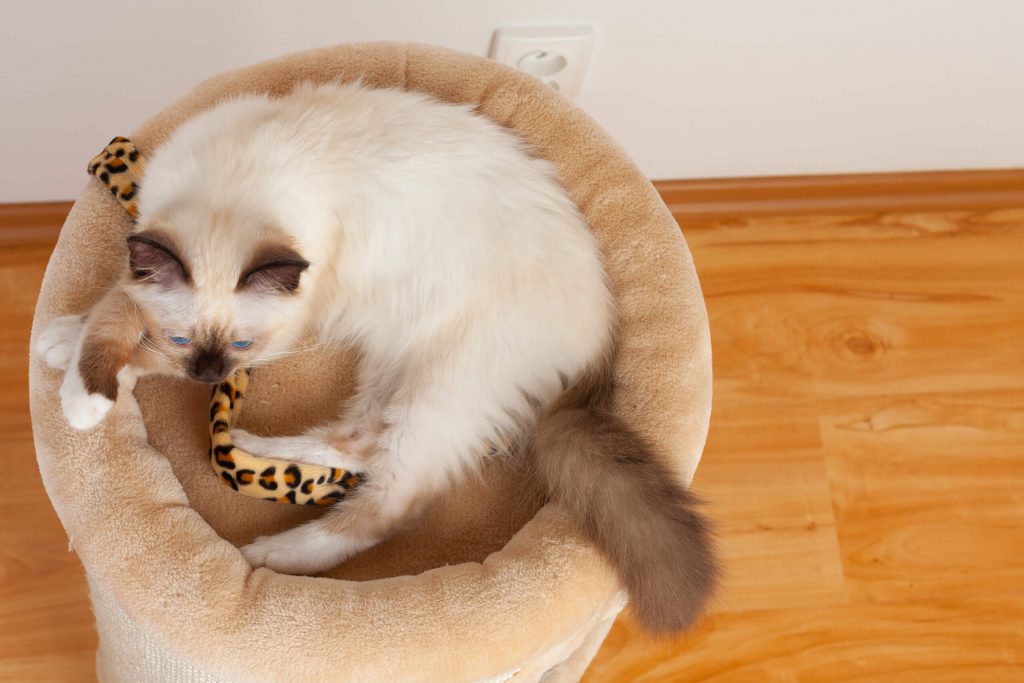
Key attributes of the Sacred Cat of Burma
The most striking attribute of the Birman cat are its four white paws. These white “gloves” and “socks” on the cat’s front and back legs are a typical attribute that set it apart from other breeds with colourpoint colouring. Ideally, the white markings are symmetrical on all paws. The markings are also higher on the Birman cat’s hind legs, which make the cats look as if they’re wearing white knee socks. In contrast to the front paws, the white colouring on the hind legs is V-shaped, extending from the ball of the paw up to the ankle.
Character of the Sacred Cat of Burma
In terms of character, the Sacred Cat of Burma is one of the more affectionate cat breeds. These cats will follow “their” humans like a second shadow. They often choose a particular member of the family and devote themselves entirely to them. Of course, this doesn’t mean they don’t like other family members too! These cats are friendly to everyone, and they’ll respect children and other animals if given enough freedom to do so. The Sacred Cat of Burma is a quiet cat, but that doesn’t mean it just lies around all day. Like all cats, it needs exercise and enough space to move around in. Members of this breed aren’t big fans of having constant hustle and bustle around them, but that doesn’t mean they’re not very playful and curious. Plus, a Sacred Cat of Burma will always be up for lots of cuddling!
Price of the Sacred Cat of Burma
What about the price? How much does a Sacred Cat of Burma cost? If you purchase a pedigree cat from a breeder, the price of a Sacred Cat of Burma will run between €800 and €1,200. What are the reasons for the big difference in price? The price of a pedigree cat always depends on its lineage, that is, which set of parents it descends from. The price will also depend on the sex of the cat and the breeder’s expenses. If you purchase a Sacred Cat of Burma, you should make sure the breeder also provides you with proof that the cat has been dewormed and vaccinated. Would you prefer a kitten or an older cat? The age of your new furry friend can also affect the price and maintenance costs.
Breeding the Sacred Cat of Burma
France played an important role in the breeding of the Sacred Cat of Burma. The first lines of breeding can be traced back to that country, which means that it’s thanks to French breeders that the Sacred Cat of Burma was able to gain a foothold in Europe. In order to create a solid foundation stock, the breeders initially crossed Siamese cats with bicolour long-haired cats. After 1945, in an attempt to expand and stabilise the foundation stock, Balinese, Persian and domestic cats were also crossed into the Sacred Cat of Burma breeding lines. In the mid-1950s, the Sacred Cat of Burma managed to conquer Great Britain. These cats became a hit in the United States at the end of the 1950s and in Germany in the 1960s. Today, Birman cats are recognised as an independent cat breed.
Interesting facts about keeping and caring for the Sacred Cat of Burma
The care and maintenance of the Sacred Cat of Burma should always be in line with the particular needs of these friendly cats. They’re quiet cats who appreciate being able to retreat to their favourite
places. Birman cats are sociable and need contact with others – either with other cats, animal housemates or humans. If they have this contact, they’ll be happy. A well-balanced Birman is a source of absolute tranquillity! Most Birman cats are not very talkative, but they know how to draw attention to themselves. They’ll use their deep-mountain-lake gaze to captivate you and then use their body language to make sure their every wish is quickly fulfilled.
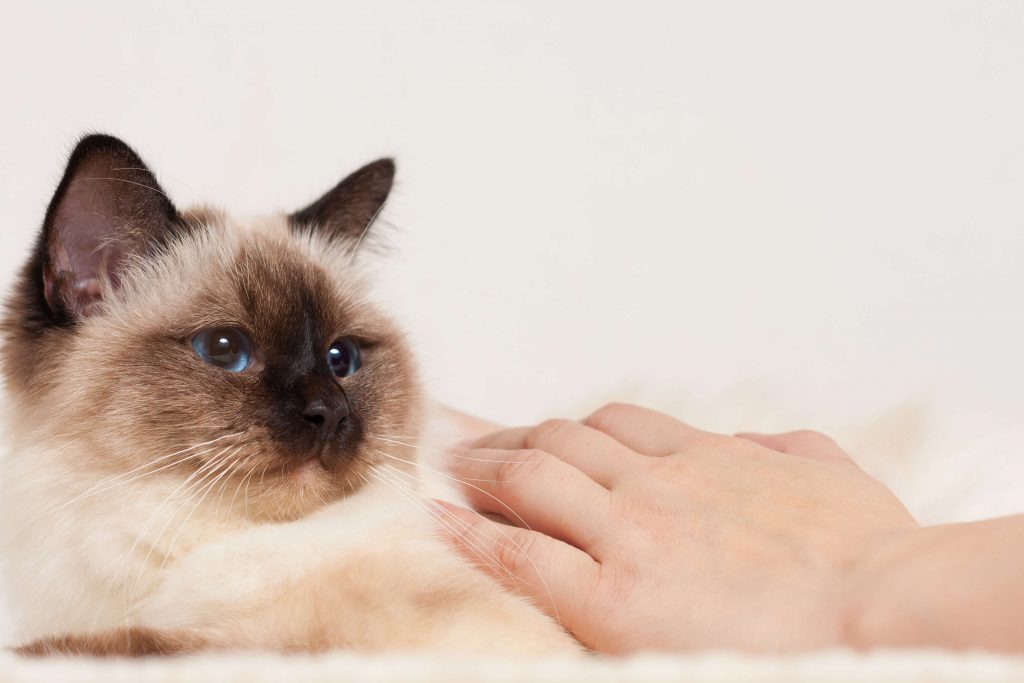
Sacred Cat of Burma Kitten
Sacred Cat of Burma kittens are entirely white when they’re born. The markings on their faces and legs develop gradually, and it can take up to a year for the kittens to get darker fur on their extremities. Once they have these “points”, they’ll no longer look like fluffy snowflakes, but instead like “real” adult Birman cats! One Birman kitten is a beautiful thing, but two – or three – are even better! These cuddly sociable cats need company! If you have two of them, you’ll generate even more cat happiness right from the start. When you bring your Birman kittens home, it will mark the beginning of a new phase in their lives – one that will forever shape their life together. It’s an exciting time that will eventually present these little fur balls with real challenges! The kittens will first have to find their way in a completely new world, where everything is new and unfamiliar, so of course this is easier in pairs!
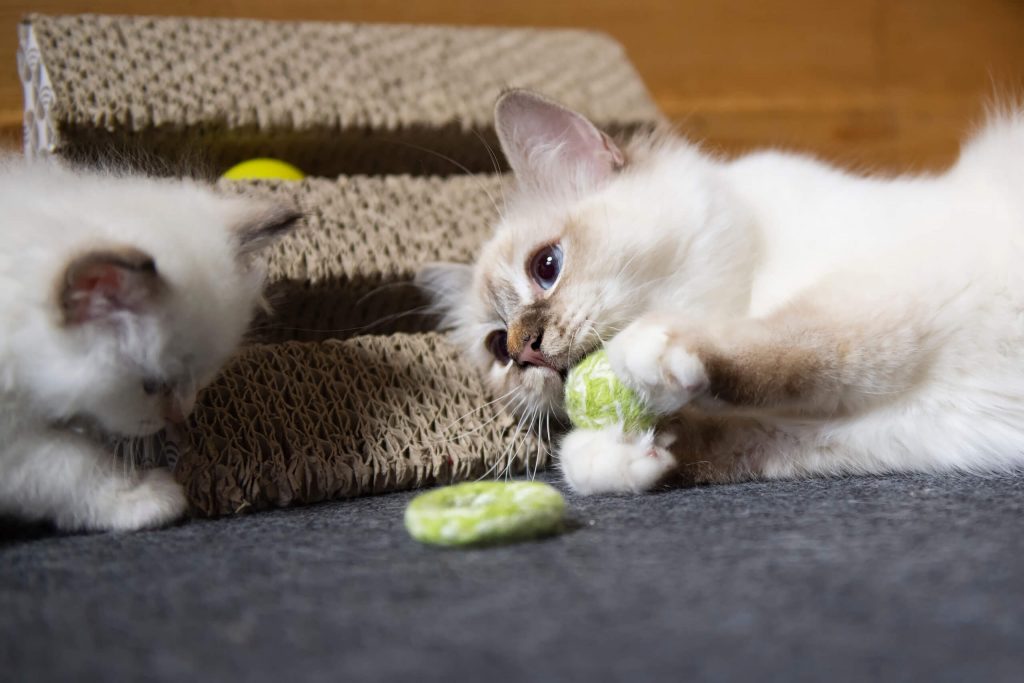
Typical diseases of the Sacred Cat of Burma
Typical diseases such as hypotrichosis, hypertrophic cardiomyopathy and polycystic kidney disease can occur in the Sacred Cat of Burma. It’s important to diagnose and treat diseases as early as possible, which means that Birman cats with any noticeable or suspected symptoms should be examined by a veterinarian as a precautionary measure. Why is this important? When a vet is able to diagnose the disease early on and prescribe a treatment suitable to your cat, it might actually be possible to prevent the disease from getting worse. In other words, the right treatment at the right time can give your cat the opportunity to lead a carefree life without any serious health problems.
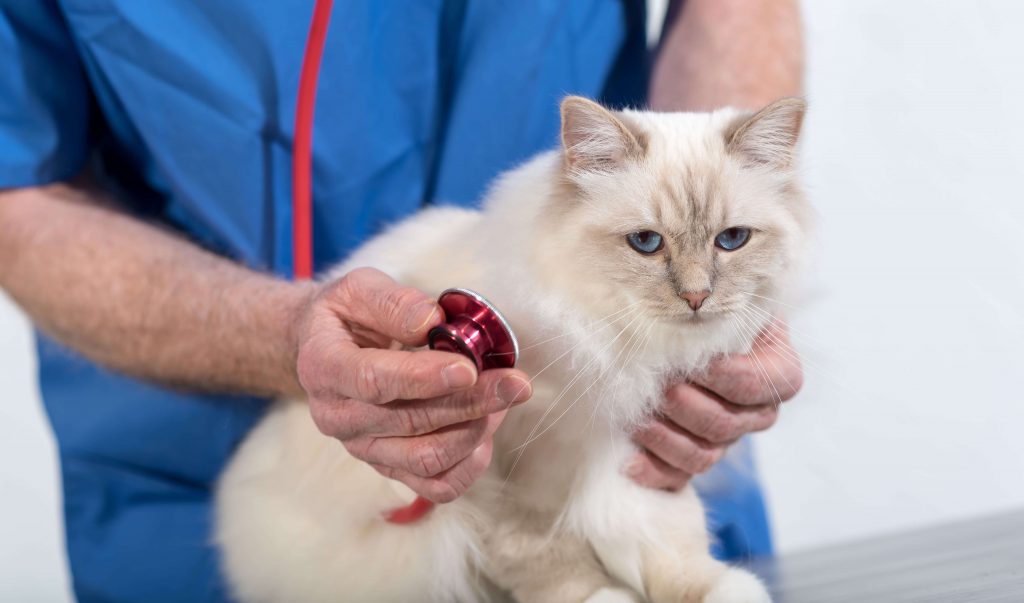
Life expectancy of the Sacred Cat of Burma
The average life expectancy of the Birman cat is 12 to 15 years. As you probably already know, many people believe that cats have more than one life. It’s a bold theory and probably derives from the fact that cats are very clever and adaptable; they have razor-sharp powers of perception that often save their necks, even in life-threatening situations. Unfortunately, these powers can’t always prevent outdoor cats from suffering injuries and sometimes worse, for example, when crossing a busy road or coming into contact with harmful substances in their territory. When cats live exclusively indoors and
are protected from such dangers, they have a better chance of growing old.

